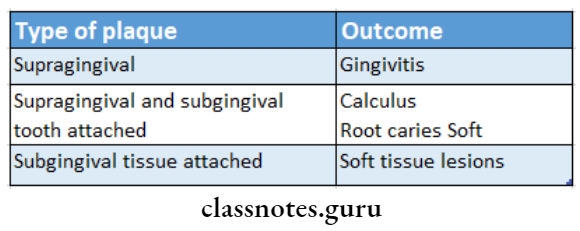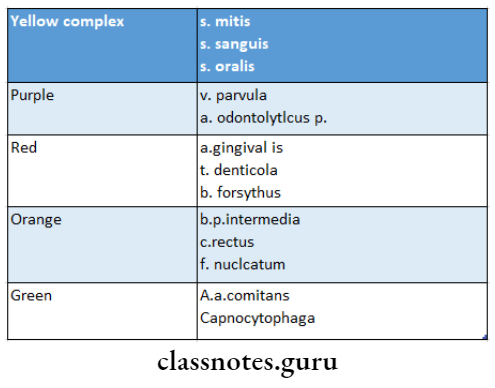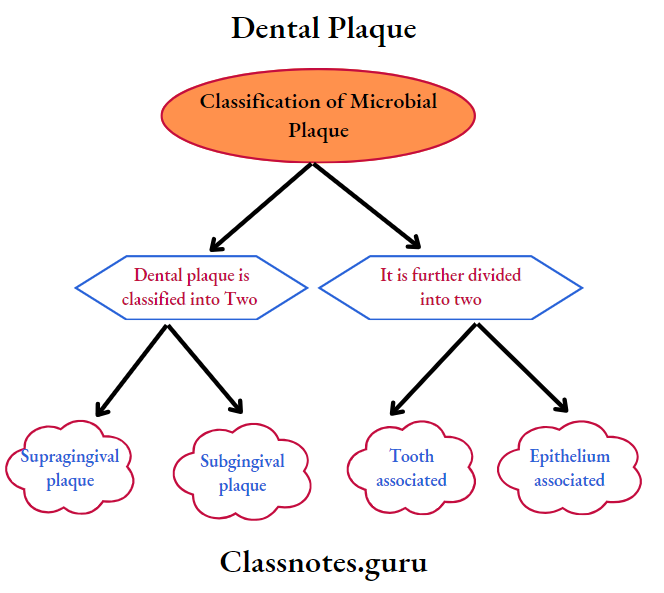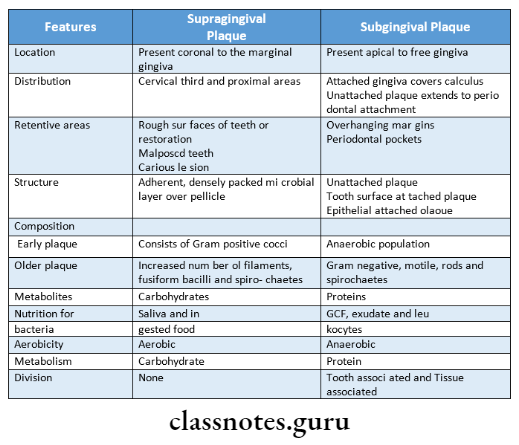Dental Plaque Definitions
1. Dental plaque
Dental plaque is soft deposits that form biofilm adhering to the tooth surface or other hard surfaces in the oral cavity including removable and fixed restoration

Dental Plaque Classification
Dental plaque is classified into
- Supra gingival plaque
- Subgingival plaque
- It is further divided into
- Tooth associated
- Epithelium associated
- It is further divided into
Read And Learn More: Periodontics Question and Answers
Dental Plaque Important Notes
- Early Plaque contains streptococcus sanguis and Actinomyces viscosus. Late plaque contains p.gingivalis, p. media, fusobacterium and capnocytophaga
- Type Of Plaque and its outcome
- Stages Of Formation Of Plaque
- Formation of pellicle
- Initial colonization of the tooth surface
- Secondary colonization and plaque maturation

4. Socransky’s Postulate
- It is for the identification of causative agents
- No. of etiologic organisms in the diseased site must be increased
- While it should be reduced in healthy sites
- If an etiologic organism is eliminated then disease progression ceases
- Presence of antibodies in organisms
- Presence of virulence factors
- In vitro, experiments should demonstrate the disease process
5. Composition Of Plaque
- Micro-organisms
- Bacteria
- Mycoplasm
- Fungi
- Protozoa
- Virus
- Intracellular matrix
- Organic
- Carbohydrates
- Glycoproteins
- Lipids
- Inorganic
- Calcium
- Phosphorous
- Magnesium
- Potassium
- Sodium
6. Bacteria And Periodontal Health

7. Colonizers
- They contribute to biofilm formation
- Initial colonizers include co-aggregation of fusobacterium with s. sanguis, prevotella with A. viscosus
- and capo-autophagy with A viscous
- Secondary colonizers adhere to bacteria already present
- Initial colonizers form yellow or purple complexes while secondary colonizers form green, orange, or red complexes

Dental Plaque Long Essays
Question 1. Define and classify microbial plaque. Discuss the role of plaque in the etiology of gingival and periodontal disease.
Answer:
Microbial Plaque Definition:
- Microbial Plaque is soft deposits that form biofilm adhering to the tooth surface or other hard surfaces in the oral cavity including removable and fixed restoration
Microbial Plaque Classification:

Role Of Plaque In Gingivitis And Periodontitis:
- Gingivitis usually precedes periodontitis
- In the early stage of gingivitis, bacteria in plaque build up, causing the gingival to become inflamed and to easily bleed during tooth brushing.
- No irreversible bone or other tissue damage has occurred at this stage.
- When gingivitis is left untreated, it can advance to periodontitis. In a person with periodontitis, form pockets.
- These small spaces between teeth and gingival collect debris and can become infected
- As the disease progresses, the pockets deepen and more gingival tissue and bone are destroyed.
- When this happens, teeth are no longer anchored in place, they become loose, and tooth loss occurs.
Question 2. Define and classify plaque. Write in detail about its composition and ill effects.
Answer:
Classify Plaque Definition:
- Classify Plaque is soft deposits that form biofilm adhering to the tooth surface or other hard surfaces in the oral cavity including removable and fixed restoration
Classify Plaque Classification:
- Dental plaque is classified into
- Supra gingival plaque
- Subgingival plaque
- It is further divided into
- Tooth associated
- Epithelium associated
Classify Plaque Composition:
1. Microorganisms:
- Bacteria
- Mycoplasma
- Fungi
- Protozoa
- Virus
2. Intracellular matrix:
- Organic:
- Carbohydrates
- Glycoproteins
- Lipids
- Inorganic:
- Calcium
- Phosphorous
- Magnesium
- Potassium
- Sodium
Ill Effects Of Dental Plaque:
- Predisposes to caries
- Gingivitis
- Supragingival plaque matures and creates an environment for the development of subgingival plaque
- Organisms accumulate in this space
- The disease advances to periodontitis with pocket formation and bone loss
- Due to the loss of tooth-supporting bone teeth become loose and get exfoliated
Question 3. Discuss the role of Local factors in the etiology of Periodontal disease.
Answer:
Local Factors In Etiology Of Periodontal Diseases:
1. Role Of Plaque
- Gingivitis usually precedes periodontitis
- In the early stage of gingivitis, bacteria in plaque build up, causing the gingival to become inflamed and to easily bleed during tooth brushing.
- No irreversible bone or other tissue damage has occurred at this stage.
- When gingivitis is left untreated, it can advance to periodontitis. In a person with periodontitis, form pockets.
- These small spaces between teeth and gingival collect debris and can become infected
- As the disease progresses, the pockets deepen and more gingival tissue and bone are destroyed. When this happens, teeth are no longer anchored in place, they become loose, and tooth loss occurs.
2. Role Of Calculus
- Calculus provides a fixed nidus for continuous plaque accumulation
- It brings plaque bacteria close to the supporting tissues
- Interferes with a local self-cleansing defense mechanism
- Acts as a reservoir for irritating substances such as endotoxins, antigenic material, and bone-resorbing factors
- Makes plaque removal more difficult for the patient
Dental Plaque Short Essays
Question 1. Dental plaque – its definition, classification, and composition.
Answer:
Dental Plaque Definition:
Dental Plaque is soft deposits that form the biofilm adhering to the tooth surface or other hard surfaces in the oral cavity, including removable and fixed restoration.
Dental Plaque Classification:
- Dental Plaque
- Supra gingival
- Subgingival
- Tooth – associated
- Epithelium associated
Dental Plaque Composition:
Microorganisms:
- Bacteria
- Mycoplasma
- Fungi
- Protozoa
- Virus
Intracellular Matrix:
Organic:
- Carbohydrates
- Glycoproteins
- Lipids
Inorganic:
- Ca, P
- Mg, K, Na
Question 2. Specific and non-specific plaque. (or) Elaborate on various plaque hypotheses.
Answer:
Specific Plaque Hypothesis:
- The specific plaque hypothesis states that not all plaque is pathogenic, and its pathogenicity depends on the presence of certain specific microbial pathogens in plaque
- Specific microorganisms responsible for periodontal diseases release certain damaging factors called virulence factors which lead to host tissue destruction
Example: A.a. contains causes aggressive periodontitis
Non-Specific Plaque:
- It states that it is the total bulk of the plaque that determines the pathogenicity rather than the individual species in it
- According to it, If a small amount of plaque is present, then the products released by it can be neutralized by the host
- But if it is present in large quantity, then it alters the host response
- It forms the basis of recent treatment and prevention modalities
Question 3. Structure of dental plaque.
Answer:
1. Supra gingival plaque:
- Supra Gingival Plaque adheres to the tooth surface
- Supra Gingival Plaque contains Gram-positive cocci and Gram-negative rods and filaments
- The arrangement is described as Corncob arrangement- ment
- The central core consists of rod-shaped bacterial cells like Fusobacterium nucleatum
- Coccal cells like streptococci get attached to it
2. Sub gingival plaque:
- Sub Gingival Plaque contains many large filaments with flagella
- Sub-Gingival Plaque is rich in spirochetes
Tooth-Associated Plaque:
- Tooth-associated plaque structure is similar to supra-gingival plaque
Tissue-Associated Plaque:
- The extracellular matrix is not well-defined and contains numerous bristle brush formations
- Tissue-associated plaque forms test tube brush formation
- Tissue-associated plaqueis characterized by large filaments that form the long axis
- Short filaments or Gram-negative rods get embedded in the matrix

Question 4. Differences between supra and subgingival plaque.
Answer:

Dental Plaque Viva Voce
- 1 gm of plaque contains 2*1011 bacteria
- Organisms that predominate in early plaque are gram-positive cocci and rods
- In late plaque, organisms present are gram-negative anaerobic rods and filament
- Supra gingival plaque typically demonstrates corncob structures
- Plaque is the most common cause of gingivitis and periodontitis
- Material alba is a yellowish or white soft sticky deposit and is less adherent
- A. actinomycete contains is a facultative anaerobe
- The red complex is associated with bleeding on probing.
